Chillies are a staple ingredient in the kitchen, especially in many Asian recipes. I love adding chillies to recipes, whether it’s a fresh one, dried flakes, or as a hot chilli sauce.
As I use so many, I started to wonder how easy it would be to grow my own chillies at home. I loved the idea of having a never ending supply of fresh chillies, and I was particularly intrigued by the opportunity to grow a wider variety than the ones available in the supermarket.
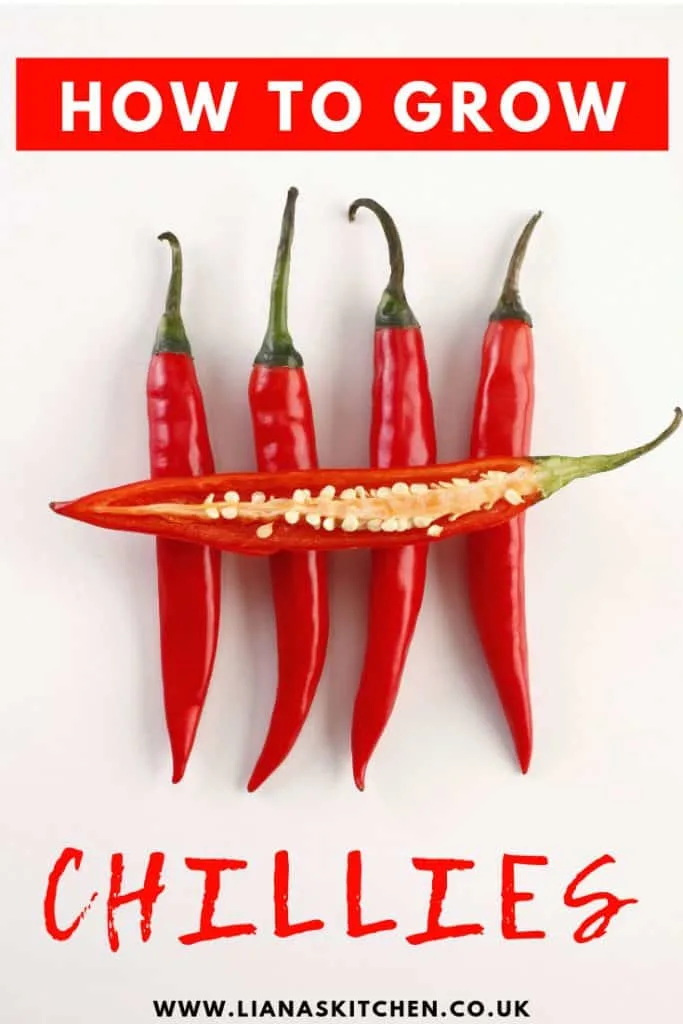
Now I’ll hold my hands up here and confess that when it comes to growing things (and keeping them alive), I have a low success rate. For a variety of reasons I never seem to be able to master it.
Thankfully my eldest son has a natural passion for planting and growing things and was only too pleased to help me out with my ambitious project – to see how many of our own ingredients we could grow.
I wanted to create the ultimate guide to growing chillies at home, whether it was indoors on the kitchen windowsill, or outdoors in a greenhouse. I will continue to update this resource as we learn new things. I’ll also link through to all the tasty recipes we end up making with our fresh haul of chillies!
So, with the tremendous help and advice from Ben, please enjoy this first in a series of guides on How To Grow Your Own Food At Home.
How To Grow Chillies At Home – A Step By Step Guide
This guide will show you the many methods of growing chillies, as well as the many things you can do with chillies once you’ve grown them! To Start off with I have listed out some of the most frequently asked questions about growing chillies.
This guide begins with some of the most frequently asked questions about growing chillies, continuing on to the different methods of growing chillies, whether it be from seed, or a young plant. Next, I will explain how to harvest, store and use your beautifully home grown chillies and finally, to complete the guide, I finish off with some fun facts about chillies!
Common Questions About Growing Chillies
1. Do Chilli Plants Need Sun Or Shade?
Given the choice, chilli plants love the sun! They will need direct sunlight to flourish, although some shade is ok.
2. How Long Does It Take For A Chilli Plant To Bear Fruit?
This very much depends on the variety. Some can take as little as 60 days, others closer to 120 days.
3. Do Chilli Plants Grow All Year Round?
Chilli plants won’t last through the winter if left to their own devices outside. You will need to bring them inside and follow an ‘overwintering’ process. It will require warmth, sunlight as well as water and feed.
4. How Long Do Chilli Seeds Last?
Usually 2 to 3 years, as long as they are stored correctly. They need to be dried out and kept in a cool and dark location.
5. Do You Need To Feed A Chilli Plant?
However you decide to grow them, all chillies will benefit greatly from a feed once a week when they start to flower. You can choose a feed such as Chilli Focus, or use a tomato fertilizer. Chilli Focus is available in many garden centres, as well as online.
6. How Long Do Chilli Seeds Take To Germinate?
They should take around 10 to 14 days. Take this as a rough guide, some begin to sprout a lot sooner, whereas some take a little longer. If they are not showing any signs of germination try moving them to a warmer location (airing cupboards are a great place!)
7. Do Chilli Plants Die After Fruiting?
No they don’t. As long as you harvest all the chillies and prune it back. See No.3 for information on getting them to survive the winter.
8. Do Chilli Plants Need Lots Of Water?
Not as much as you might think. Don’t be tempted to over water a chilli plant. They usually need a decent watering and then left until the compost completely dries out. Don’t let the pot stand in water.
9. Can I Grow A Chilli Plant Indoors?
Absolutely. As long as they have enough heat, sunlight, moisture and humidity they will grow just fine. However, they won’t grow as large as those outside.
10. How Can I Make My Chilli Plant Grow Faster?
A heated propagator is needed to speed up the germination and initial growth period.
3 Different Ways To Grow Chillies At Home
1. Growing Chillies From Seed
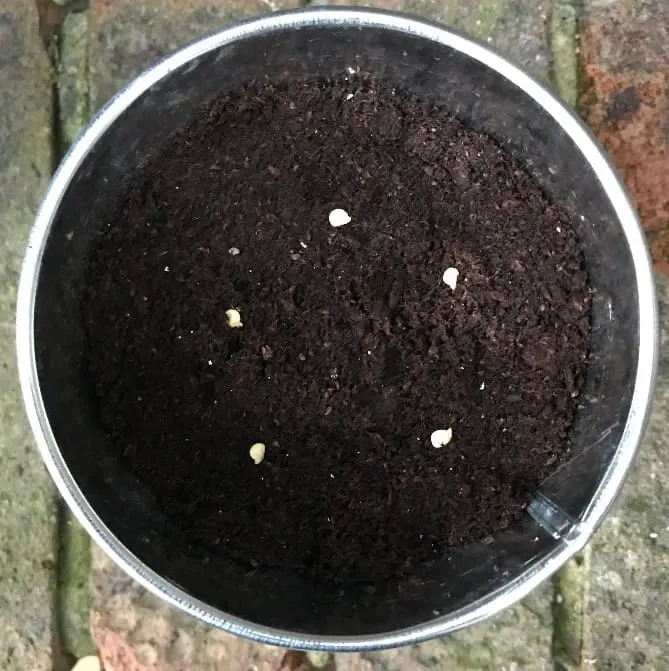
Growing chillies from seed is a great thing to do, especially with the kids – and some varieties produce peppers in as little as 60 days from pot to plate! Chilli plants will need protection from frosts, so ideally, sow them indoors during the winter, unless you are in a warmer climate.
What You Will Need
- multipurpose compost
- chilli seeds
- cling film
- small pots for sowing
- larger pots for final growing (around 30cm/12inch wide)
- bamboo canes and string/twine.
- small stones/gravel/broken terracotta for drainage
- fertilizer
Where To Buy Chilli Seeds
Chilli seeds are relatively cheap, at around £1 or £2 in shops in spring, but if you have a more obscure variety in mind, then be prepared to pay £3 or £4, as these will likely be specialist seeds.
You can also buy them online if you can’t access a shop. And finally, you can collect and grow your own seeds, by simply taking them out of a chilli you have. Sow straight away, or store and sow for up to a year.
When To Sow Chilli Seeds
You can sow chilli seeds any time from around the beginning of January until the end of Spring. If you sow them in late winter they will have a much longer time to ripen up.
How To Sow Chilli Seeds
- Prepare a small pot with drainage by filling it with compost, and gently watering it. Sprinkle a couple of seeds on top, and cover with a thin layer of compost.
Chilli seeds germinate best at 25°C, so if it’s a little cold where they are growing, they may benefit from being wrapped in a plastic bag, covered in cling film, or put in a propagator. - Leave on a warm and light windowsill. Keep consistently moist, and the seeds should germinate within a week or two. When the seeds have germinated, remove the cling film or plastic cover. You can also leave them to germinate in an airing cupboard or by a radiator. Just remember to keep checking on them to make sure the compost doesn’t dry out.
- Prick out (remove) the smallest seedlings (this is why you sowed extra, so you kept only the best), leaving the biggest one. This way you will get the maximum harvest. Remember to keep the compost moist.
- Transfer to a larger pot when the seedlings reach around 10cm in height. Keep the plant moist by watering it well.
- As the plants grow taller you will need to support it with a small bamboo cane. Gently tie the plant to the cane. Chillies can be quite heavy for the plant to carry alone 🙂
- When winter has passed, chillies can be grown outside, in a greenhouse or polytunnel, in the pots, or in the ground, but be aware that there will be pests.
- Transplant the chilli plant into a bigger pot when necessary (tip: if you can see the roots through the drainage holes, then it needs a bigger pot). Fill the larger pot with a layer of drainage material (small stones, rocks, broken terracotta plant pots) before filling up with compost and placing the plant in it.
- Water regularly. Once the chilli plant begins to flower you will need to feeding it with a tomato fertilizer once a week.
- Harvest at the end of summer/start of autumn.
Tip: Snip off the first green chillies that appear rather than leaving them to turn red. This will encourage more fruit.
2. Growing From An Established Chilli Plant
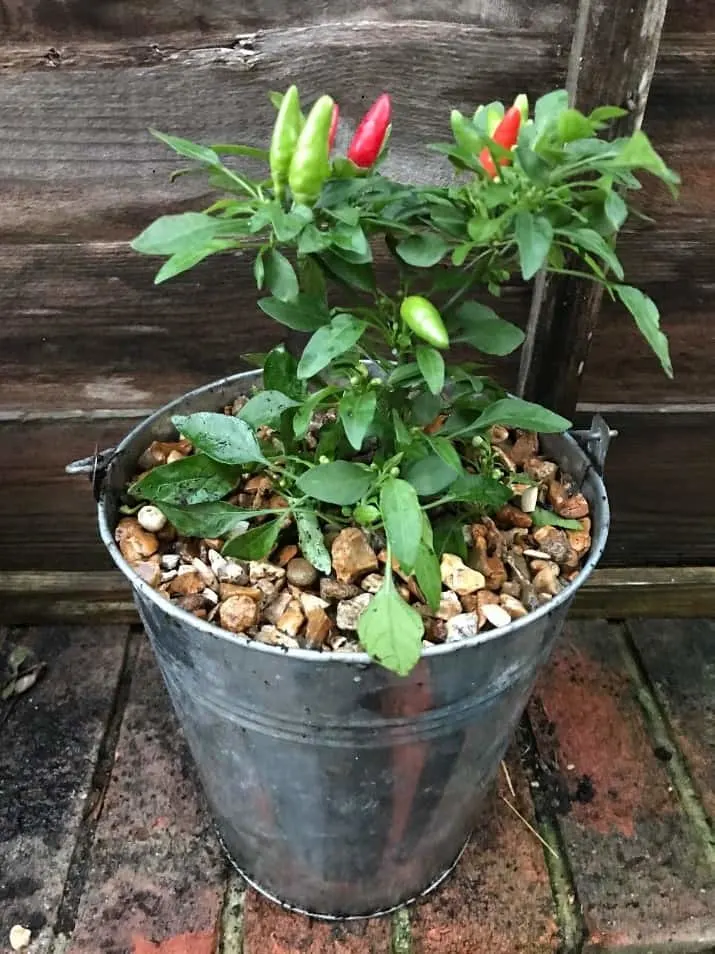 Growing chillies from a young plant is better suited for less experienced gardeners, or those in a hurry, as you don’t have to worry about the germination process.
Growing chillies from a young plant is better suited for less experienced gardeners, or those in a hurry, as you don’t have to worry about the germination process.
What You Will Need
- a larger pot than the one it came in.
- fertilizer
- multipurpose compost
- bamboo canes and string/twine
- small stones/gravel/broken terracotta for drainage
Where To Buy Chilli Plants
Young chilli plants are normally available from spring to late summer in supermarkets, although I think Waitrose sells them all year for about £2 or £3. However, younger plants that you can grow yourself are sold in garden centres, as well as many DIY stores like B&Q and Homebase. Depending on the time of year, the plant may have chillies already on it. It is likely that your choice of chillies will be limited in these places though.
3. Grow Your Own Kits
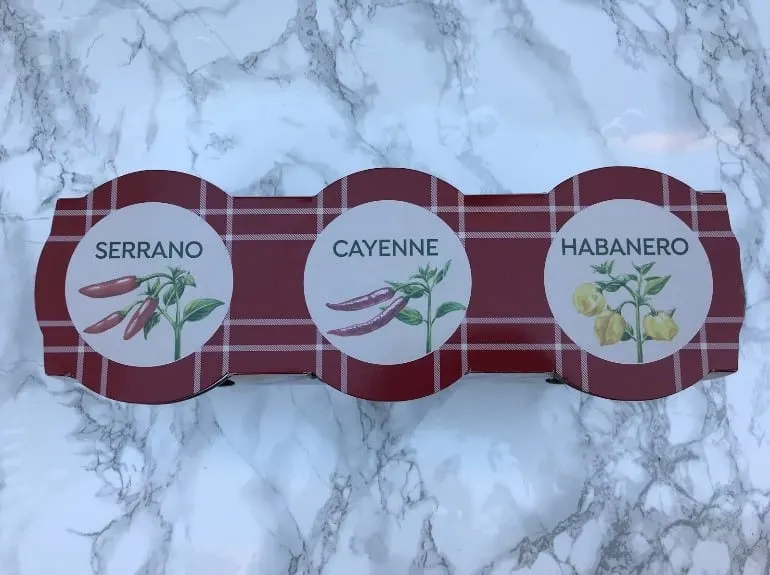
Grow your own kits come in many different forms and are sold by various companies. I have tested one that I bought from Wilkos. I bought it in November, it was the version more intended as a Christmas gift, rather than just a gardening supply.
What You Get
- 3 zinc pots with blackboard paint on them.
- 3 individually packaged bags of soil
- 3 separate sachets of seeds
- Chalk
Many grow your own kits will be comprised of something very similar, maybe with different varieties, but they are all relatively straightforward to use.
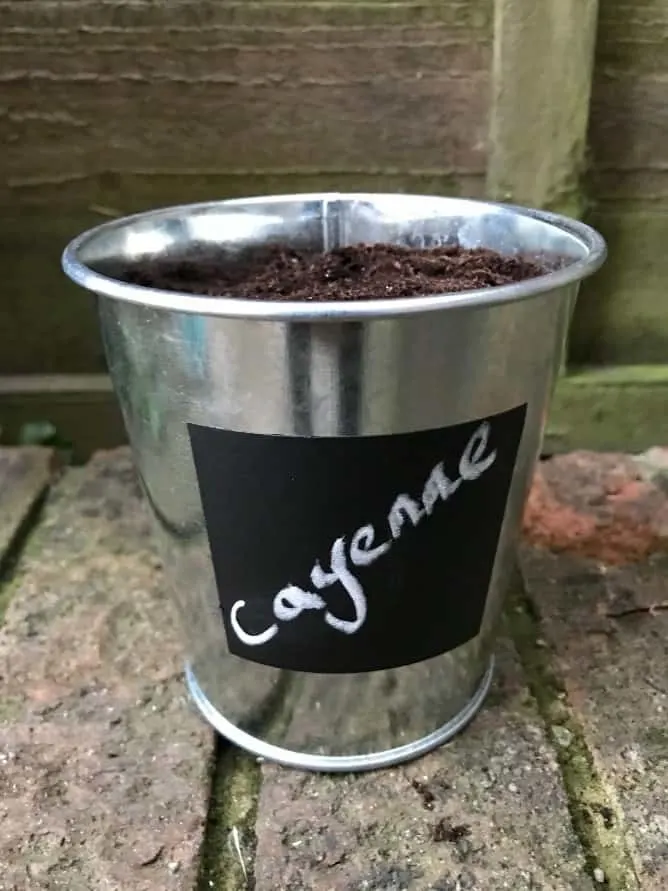
Although it didn’t say to do this, I added some stones, brick pieces and broken pots at the bottom to provide drainage for the water, as this pot didn’t have a hole in it. Thereafter, I followed the traditional method for GYO kits.
- I filled the pot most of the way up, as per the instructions.
- I sprinkled some seeds on top (but not all of them – I will keep some to sow at a later date) and covered with soil, patted down and watered gently.
Now I just have to wait for some results!
Note: Germination will happen much faster if the pots are placed in a plastic bag, or covered in cling film, to increase humidity.
Harvest: The chilli peppers can be harvested at any time, but are often bitter until they are their full size (mature), when they start ripening from green through to their ripe colour – this is usually red or yellow, but can be purple or cream, depending on the variety.
Overall Verdict
At £5, this is a fun gift that is affordable and fun, as well as being suitable for first-time growers. The pots and plants are aesthetically pleasing, and useful.
Harvesting, Storing And Using Your Home Grown Chillies
Harvesting Chillies
Chillies should be ready for picking from about July onwards. Make sure you harvest them frequently to encourage further fruiting. You can remove them from the plant with some secateurs or sharp scissors.
Storing Chillies
Hopefully all of your growing efforts will reward you with a bumper crop of chillies. It is likely you will have way more than you can use. There are various options to storing chillies long term.
Freezing
Chillies can be frozen. Just pop them in suitable freezer containers. They can be left whole or sliced. Wash them after picking then leave them to dry, or lightly pat them with a clean tea towel to speed up the drying.
Drying Chillies
Dried chillies, when done correctly can be kept for a couple of years. Once I have been through the process of drying our own chillies I will add a guide and link to it here. Essentially there are 3 different ways to dry chillies; in a purpose built food dehydrator, in an oven, or leaving them out to dry.
Related: How To Dry Chillies
Different Ways To Use Chillies
Check back to see my chilli recipes as I experiment and add them to the blog.
Chilli Oil
Chilli Flakes
Hot Chilli Sauce
Sweet Chilli Sauce
Chilli Jam/Preserve
Chilli Chocolate

Joe Greene
Saturday 8th of February 2020
I am in my sophomore year of growing hot peppers! I learned alot by all the mistakes I made! I have 4 plants that I'm overwintering by covering them with a Planket so far so good! I live in zone 9b I think my odds are good!
Liana Green
Monday 10th of February 2020
Hi Joe - thanks for your comment! That's great to hear you are having success growing hot peppers! It's always interesting to hear from people from different parts of the world having success with growing them. I love hot peppers so growing them at home is lots of fun :)